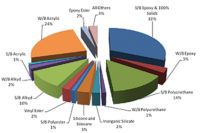Strategic Solutions: The True Meaning of Green
Neither the adhesives industry nor the coatings industry can fly info a “green” future, nor should they try.

For many years, we have been hearing about green adhesives, paints, household cleaners and buildings—basically, green everything. With the majority of U.S. consumers, numerous non-governmental organizations, such as the U.S. Green Building Council (which developed the LEED green building program), as well as countless special interest groups and various state and federal agencies all pushing for “green” materials in every phase of life, it seems like we should have made significant progress toward a greener world by the year 2013. The fact that we are not closer to that new paradigm sometimes seems puzzling—until one starts to take a closer look at the reasons why the sustainability movement is moving so much more slowly than most of us would have thought a decade ago.
Consumer Behavior
Let’s start with the consumer. Countless polls have shown that more than 80% of consumers favor the introduction of green products in all phases of the economy, but only about 17% of them actually purchase green products. It seems they only do so when the premium for buying green is generally no more than 5% over the non-green version of whatever they are purchasing. A premium of greater than 5% tends to represent what we in the business refer to as the “kiss of death.”
Add to this the confusion of what “sustainable” means, both to consumers and industrial producers and users, and it is no wonder that progress is being made more slowly than many people and organizations would like—although both the adhesives and coatings industries are clearly headed in a green and sustainable direction.
Clarifying Definitions
Since the terms “green” and “sustainable” tend to vary in their meanings for different people and organizations, it might be helpful—for the purposes of discussion—to recognize that virtually any green materials or practices are also sustainable materials or practices. While this might not be true 100% of the time, it is a good place to start.
Under this understanding, both “green” and “sustainable” could be roughly defined by using this definition (for “sustainable”) developed by the World Business Council for Sustainable Development: “The delivery of competitively priced goods and services that satisfy human needs and bring quality of life, while progressively reducing ecological impacts and resource intensity to a level at least in line with the Earth’s estimated carrying capacity.”
The Color of Green
So what color is green? Does “green” come from bio-based materials made from renewable sources? Certainly. The death of alkyds was predicted 40 years ago, but alkyd coatings based on resins that contain high levels of bio-renewable oils and fatty acids are alive and well. In fact, places like the College of Polymer Science and Polymer Engineering at the University of Akron are working to create new alkyds with improved properties. Similarly, citrus cleaners are based on the chemical limonene (which is yellow), a byproduct of the orange juice industry.
Is “green” really the color of silver, platinum or gold, as in the case of LEED-certified buildings? Here, the emphasis is on a building’s efficient use of energy and other natural resources. Making energy produces carbon dioxide (CO2), while consuming less energy means producing less CO2.
Perhaps “green” is really colorless. Greenhouse gases (primarily CO2, but also methane, nitrous oxides, ozone, and others) are the issue. Learning to reduce our dependency on finite resources derived from oil and natural gas is the issue. Sustainability is all about making proper choices. No single color can be used to describe this choice, and you need to be prepared to do hard work, which will lead to small—but important—gains. In the words of Friedrich Nietzsche, “He who would learn to fly one day must first learn to stand and walk and run and climb and dance; one cannot fly into flying.”
Future Goals
Neither the adhesives industry nor the coatings industry can fly into a “green” future, nor should they try. By making small, continual, deliberate steps in the right direction, both industries, which have so many raw material components and end-use applications in common, will become “greener,” and that is really the point.
Starts, stops and ongoing course corrections are expected to occur along the way. For example, is it really “greener,” when all is said and done, to make ethanol from corn than from natural gas? The jury still seems to be out on that. Change and revisions should be expected, however, and the adhesives industry will need to be flexible as we attempt to make our products greener. Absolute green and complete sustainability are not yet within our reach, but relative green and a greater degree of sustainability are—and that should be the goal.
Looking for a reprint of this article?
From high-res PDFs to custom plaques, order your copy today!




